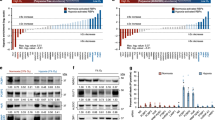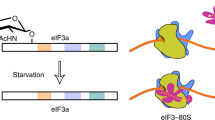Abstract
Protein synthesis involves the translation of ribonucleic acid information into proteins, the building blocks of life. The initial step of protein synthesis is the binding of the eukaryotic translation initiation factor 4E (eIF4E) to the 7-methylguanosine (m7-GpppG) 5′ cap of messenger RNAs1,2. Low oxygen tension (hypoxia) represses cap-mediated translation by sequestering eIF4E through mammalian target of rapamycin (mTOR)-dependent mechanisms3,4,5,6. Although the internal ribosome entry site is an alternative translation initiation mechanism, this pathway alone cannot account for the translational capacity of hypoxic cells7,8. This raises a fundamental question in biology as to how proteins are synthesized in periods of oxygen scarcity and eIF4E inhibition9. Here we describe an oxygen-regulated translation initiation complex that mediates selective cap-dependent protein synthesis. We show that hypoxia stimulates the formation of a complex that includes the oxygen-regulated hypoxia-inducible factor 2α (HIF-2α), the RNA-binding protein RBM4 and the cap-binding eIF4E2, an eIF4E homologue. Photoactivatable ribonucleoside-enhanced crosslinking and immunoprecipitation (PAR-CLIP)10 analysis identified an RNA hypoxia response element (rHRE) that recruits this complex to a wide array of mRNAs, including that encoding the epidermal growth factor receptor. Once assembled at the rHRE, the HIF-2α–RBM4–eIF4E2 complex captures the 5′ cap and targets mRNAs to polysomes for active translation, thereby evading hypoxia-induced repression of protein synthesis. These findings demonstrate that cells have evolved a program by which oxygen tension switches the basic translation initiation machinery.
This is a preview of subscription content, access via your institution
Access options
Subscribe to this journal
Receive 51 print issues and online access
$199.00 per year
only $3.90 per issue
Buy this article
- Purchase on Springer Link
- Instant access to full article PDF
Prices may be subject to local taxes which are calculated during checkout




Similar content being viewed by others
References
Gebauer, F. & Hentze, M. W. Molecular mechanisms of translational control. Nature Rev. Mol. Cell Biol. 5, 827–835 (2004)
Sonenberg, N. & Hinnebusch, A. G. Regulation of translation initiation in eukaryotes: mechanisms and biological targets. Cell 136, 731–745 (2009)
Braunstein, S. et al. A hypoxia-controlled cap-dependent to cap-independent translation switch in breast cancer. Mol. Cell 28, 501–512 (2007)
Brugarolas, J. et al. Regulation of mTOR function in response to hypoxia by REDD1 and the TSC1/TSC2 tumor suppressor complex. Genes Dev. 18, 2893–2904 (2004)
Koritzinsky, M. et al. Gene expression during acute and prolonged hypoxia is regulated by distinct mechanisms of translational control. EMBO J. 25, 1114–1125 (2006)
Liu, L. et al. Hypoxia-induced energy stress regulates mRNA translation and cell growth. Mol. Cell 21, 521–531 (2006)
Holcik, M. & Sonenberg, N. Translational control in stress and apoptosis. Nature Rev. Mol. Cell Biol. 6, 318–327 (2005)
Young, R. M. et al. Hypoxia-mediated selective mRNA translation by an internal ribosome entry site-independent mechanism. J. Biol. Chem. 283, 16309–16319 (2008)
Merrick, W. C. Eukaryotic protein synthesis: still a mystery. J. Biol. Chem. 285, 21197–21201 (2010)
Hafner, M. et al. Transcriptome-wide identification of RNA-binding protein and microRNA target sites by PAR-CLIP. Cell 141, 129–141 (2010)
Yarden, Y. & Sliwkowski, M. X. Untangling the ErbB signalling network. Nature Rev. Mol. Cell Biol. 2, 127–137 (2001)
Franovic, A. et al. Translational up-regulation of the EGFR by tumor hypoxia provides a nonmutational explanation for its overexpression in human cancer. Proc. Natl Acad. Sci. USA 104, 13092–13097 (2007)
Ivan, M. et al. HIFα targeted for VHL-mediated destruction by proline hydroxylation: implications for O2 sensing. Science 292, 464–468 (2001)
Jaakkola, P. et al. Targeting of HIF-α to the von Hippel–Lindau ubiquitylation complex by O2-regulated prolyl hydroxylation. Science 292, 468–472 (2001)
Kaelin, W. G., Jr & Ratcliffe, P. J. Oxygen sensing by metazoans: the central role of the HIF hydroxylase pathway. Mol. Cell 30, 393–402 (2008)
Semenza, G. L. Regulation of mammalian O2 homeostasis by hypoxia-inducible factor 1. Annu. Rev. Cell Dev. Biol. 15, 551–578 (1999)
Wiesener, M. S. et al. Widespread hypoxia-inducible expression of HIF-2α in distinct cell populations of different organs. FASEB J. 17, 271–273 (2003)
Lin, J. C., Hsu, M. & Tarn, W. Y. Cell stress modulates the function of splicing regulatory protein RBM4 in translation control. Proc. Natl Acad. Sci. USA 104, 2235–2240 (2007)
Lin, J. C. & Tarn, W. Y. RNA-binding motif protein 4 translocates to cytoplasmic granules and suppresses translation via argonaute2 during muscle cell differentiation. J. Biol. Chem. 284, 34658–34665 (2009)
Kazan, H., Ray, D., Chan, E. T., Hughes, T. R. & Morris, Q. RNAcontext: a new method for learning the sequence and structure binding preferences of RNA-binding proteins. PLOS Comput. Biol. 6, e1000832 (2010)
Ray, D. et al. Rapid and systematic analysis of the RNA recognition specificities of RNA-binding proteins. Nature Biotechnol. 27, 667–670 (2009)
Pause, A. et al. Insulin-dependent stimulation of protein synthesis by phosphorylation of a regulator of 5′-cap function. Nature 371, 762–767 (1994)
Richter, J. D. & Sonenberg, N. Regulation of cap-dependent translation by eIF4E inhibitory proteins. Nature 433, 477–480 (2005)
Rom, E. et al. Cloning and characterization of 4EHP, a novel mammalian eIF4E-related cap-binding protein. J. Biol. Chem. 273, 13104–13109 (1998)
Tee, A. R., Tee, J. A. & Blenis, J. Characterizing the interaction of the mammalian eIF4E-related protein 4EHP with 4E-BP1. FEBS Lett. 564, 58–62 (2004)
Parsyan, A. et al. mRNA helicases: the tacticians of translational control. Nature Rev. Mol. Cell Biol. 12, 235–245 (2011)
Yi, X. et al. Sequencing of 50 human exomes reveals adaptation to high altitude. Science 329, 75–78 (2010)
Kuehn, B. M. Genomics illuminates a deadly brain cancer. J. Am. Med. Assoc. 303, 925–927 (2010)
Franovic, A., Holterman, C. E., Payette, J. & Lee, S. Human cancers converge at the HIF-2α oncogenic axis. Proc. Natl Acad. Sci. USA 106, 21306–21311 (2009)
Giatromanolaki, A. et al. Expression of hypoxia-inducible carbonic anhydrase-9 relates to angiogenic pathways and independently to poor outcome in non-small cell lung cancer. Cancer Res. 61, 7992–7998 (2001)
Gunaratnam, L. et al. Hypoxia inducible factor activates the transforming growth factor-α/epidermal growth factor receptor growth stimulatory pathway in VHL−/− renal cell carcinoma cells. J. Biol. Chem. 278, 44966–44974 (2003)
Smith, K. et al. Silencing of epidermal growth factor receptor suppresses hypoxia-inducible factor-2-driven VHL−/− renal cancer. Cancer Res. 65, 5221–5230 (2005)
Acknowledgements
We thank J. Côté, W. Kaelin, C. Kennedy and T. Tuschl for reagents and technical advice. This work was funded by the Canadian Institutes of Health Research (S.L. and M.H.). J.U. is a Research Fellow of the Terry Fox Foundation (Canadian Cancer Society Award no. 700014). A.F. was supported by a Terry Fox Foundation Studentship from the Canadian Cancer Society.
Author information
Authors and Affiliations
Contributions
J.U. performed most experiments and made most of the plasmid constructs, with assistance from C.E.H. (who identified RBM4 interaction with HIF-2α, participated in PAR-CLIP experiments, and made some luciferase contructs), G.L. (who performed experiments with human renal proximal tubular epithelial cells), A.F. (who performed actinomycin D experiments on total hypoxic EGFR levels, created stable shHIF-2α and shHIF-1α cell lines and some plasmid constructs), M.D.J. (who created luciferase constructs for CGG mutagenesis and rHRE mapping and created HIF-2α truncation mutants), M.R.F. (who performed eIF4E2 co-IP assays) and J.P. (who created some luciferase constructs). J.U., C.E.H., G.L., A.F., M.R.F., M.H., A.P. and S.L. conceived the experiments and analysed the data. J.U. and S.L. wrote the paper.
Corresponding author
Ethics declarations
Competing interests
The authors declare no competing financial interests.
Supplementary information
Supplementary Information
This file contains Supplementary Figures 1-30, Supplementary Tables 1-2 and Supplementary Methods. (PDF 3520 kb)
Supplementary Data 1
This file contains a list of RBM4 PAR-CLIP mRNA targets. (XLS 638 kb)
Supplementary Data 2
This file contains a list of HIF-2α/RBM4 PAR-CLIP mRNA targets. (XLS 246 kb)
Rights and permissions
About this article
Cite this article
Uniacke, J., Holterman, C., Lachance, G. et al. An oxygen-regulated switch in the protein synthesis machinery. Nature 486, 126–129 (2012). https://doi.org/10.1038/nature11055
Received:
Accepted:
Published:
Issue Date:
DOI: https://doi.org/10.1038/nature11055
This article is cited by
-
Spatial functional mapping of hypoxia inducible factor heterodimerisation and immune checkpoint regulators in clear cell renal cell carcinoma
BJC Reports (2024)
-
Cell-type-specific translational control of spatial working memory by the cap-binding protein 4EHP
Molecular Brain (2023)
-
Stress decreases spermatozoa quality and induces molecular alterations in zebrafish progeny
BMC Biology (2023)
-
A dual role of RBM42 in modulating splicing and translation of CDKN1A/p21 during DNA damage response
Nature Communications (2023)
-
Whole genome sequencing reveals signals of adaptive admixture in Creole cattle
Scientific Reports (2023)
Comments
By submitting a comment you agree to abide by our Terms and Community Guidelines. If you find something abusive or that does not comply with our terms or guidelines please flag it as inappropriate.



